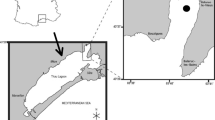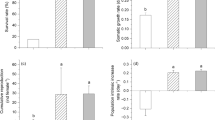Abstract
Mesozooplankton provide oxic and anoxic microhabitats for associated bacteria, whose carbon substrate usage activities complement those of the ambient bacteria. The metabolic profiles of bacterial communities associated with the calanoid copepod Acartia tonsa under aerobic and anaerobic conditions were examined in comparison with phytoplankton-associated bacteria. Carbon substrate usage by phytoplankton-associated bacteria was significantly different than that of copepod-associated bacteria in both aerobic and anaerobic conditions. Substrate utilization by copepod-associated bacteria was more dependent upon oxygen condition than whether the bacteria were located on the copepod exoskeleton or within the gut. Results suggest that gut bacteria were responsible for a large portion of anaerobic substrate usage by copepod-associated bacteria. The metabolic profiles of bacteria associated with six common zooplankton groups and free-living bacteria collected in July 2012 from the York River estuary, Virginia, (37°14′50.36″N, 76°29′58.03W) were also compared, and there were significant differences in their substrate utilization patterns between aerobic and anaerobic incubations, and among the different zooplankton groups. Through trophic interactions, phytoplankton-associated or free-living bacteria may be introduced to the anoxic zooplankton gut and its associated bacterial community. Inclusion of these anaerobic microenvironments and their microbial inhabitants increased the total number of substrates used by 57 % over what was used by aerobic phytoplankton-associated bacteria alone, and by 50 % over what was used by aerobic free-living bacteria in the York River. Therefore, the presence of zooplankton-associated microhabitats and their bacteria expanded the functionality of aquatic microbial communities and led to a more comprehensive substrate usage.




Similar content being viewed by others
References
Azam F, Malfatti F (2007) Microbial structuring of marine ecosystems. Nat Rev Microbiol 5:782–791
Bickel SL, Tang KW, Grossart HP (2014) Structure and function of zooplankton-associated bacterial communities in a temperate estuary change more with time than with zooplankton species. Aquat Microb Ecol 72:1–15
Blackburn N, Fenchel T, Mitchell J (1998) Microscale nutrient patches in planktonic habitats shown by chemotactic bacteria. Science 282:2254–2256
Carman KR (1994) Stimulation of marine free-living and epibiotic bacterial activity by copepod excretions. FEMS Microbiol Ecol 14:255–261
Carman KR, Dobbs FC (1997) Epibiotic microorganisms on copepods and other marine crustaceans. Microsc Res Tech 37:116–135
Choi K, Dobbs FC (1999) Comparison of two kinds of Biolog microplates (GN and ECO) in their ability to distinguish among aquatic microbial communities. J Microbiol Methods 36:203–213
Christian BW, Lind OT (2006) Key issues concerning Biolog use for aerobic and anaerobic freshwater bacterial community-level physiological profiling. Int Rev Hydrobiol 91:257–268
Cole JJ, Findlay S, Pace ML (1988) Bacterial production in fresh and saltwater ecosystems: a cross-system overview. Mar Ecol Prog Ser 43:1–10
Condon RH, Steinberg DK, Bronk DA (2010) Production of dissolved organic matter and inorganic nutrients by gelatinous zooplankton in the York River estuary, Chesapeake Bay. J Plankton Res 32:153–170
Condon RH, Steinberg DK, del Giorgio PA, Bouvier TC, Bronk DA, Graham WM, Ducklow HW (2011) Jellyfish blooms result in a major microbial respiratory sink of carbon in marine systems. Proc Natl Acad Sci 108:10225–10230
Crump BC, Peranteau C, Beckingham B, Cornwell JC (2007) Respiratory succession and community succession of bacterioplankton in seasonally anoxic estuarine waters. Appl Environ Microbiol 73:6802–6810
Garland JL, Mills AL (1991) Classification and characterization of heterotrophic microbial communities on the basis of patterns of community-level sole-carbon-source utilization. Appl Environ Microbiol 57(8):2351–2359
Greenstone MH, Weber DC, Coudron TA, Payton ME, Hu JS (2012) Removing external DNA contamination from arthropod predators destined for molecular gut-content analysis. Mol Ecol Resour 12:464–469
Grossart HP, Dziallas C, Tang KW (2009) Bacterial diversity associated with freshwater zooplankton. Environ Microbiol Rep 1:50–55
Harris JM (1993) The presence, nature, and role of gut microflora in aquatic invertebrates: a synthesis. Microb Ecol 25:195–231
Hedges JI, Eglinton G, Hatcher PG, Kirchman DL, Arnosti C, Derenne S, Evershed RP, Kögel-Knabner I, de Leeuw JW, Littke R, Michaelis W, Rullkötter J (2000) The molecularly-uncharacterized component of nonliving organic matter in natural environments. Org Geochem 31:945–958
Heidelberg JF, Heidelberg KB, Colwell RR (2002) Bacteria of the γ-subclass Proteobacteria associated with zooplankton in Chesapeake Bay. Appl Environ Microbiol 68:5498–5507
Huq A, Small EB, West PA, Huq MI, Rahman R, Colwell RR (1983) Ecological relationships Between Vibrio cholerae and planktonic crustacean copepods. Appl Environ Microbiol 45:275–283
Karakashev D, Galabova D, Simeonov I (2003) A simple and rapid test for differentiation of aerobic from anaerobic bacteria. World J Microbiol Biotechnol 19:233–238
Kim HM, Choi DH, Hwang CY, Cho BC (2008) Nocardioides salarius sp. nov., isolated from seawater enriched with zooplankton. Int J Syst Evol Microbiol 58:2056–2064
King C, Sanders R, Shotts E Jr, Porter K (1991) Differential survival of bacteria ingested by zooplankton from a stratified eutrophic lake. Limnol Oceanogr 36:829–845
Larsson U, Hagström A (1979) Phytoplankton exudate release as an energy source for the growth of pelagic bacteria. Mar Biol 52:199–206
Li M, Yang H, Gu J (2009) Phylogenetic diversity and axial distribution of microbes in the intestinal tract of the Polychaete Neanthes glandicincta. Microb Ecol 58:892–902
Lyons MM, Dobbs FC (2012) Differential utilization of carbon substrates by aggregate-associated and water-associated heterotrophic bacterial communities. Hydrobiologia 686:181–193
Lyons MM, Ward JE, Gaff H, Hicks RE, Drake JM, Dobbs FC (2010) Theory of island biogeography on a microscopic scale: organic aggregates as islands for aquatic pathogens. Aquat Microb Ecol 20:1–13
Mannino A, Harvey HR (2000) Biochemical composition of particles and dissolved organic matter along an estuarine gradient: sources and implications for DOM reactivity. Limnol Oceanogr 45:775–788
Middelboe M, Søndergaard M, Letarte Y, Borch NH (1995) Attached and free-living bacteria: production and polymer hydrolysis during a diatom bloom. Microb Ecol 29:231–248
Møller EF (2005) Sloppy feeding in marine copepods: prey-size-dependent production of dissolved organic carbon. J Plankton Res 27:27–35
Møller EF, Riemann L, Søndergaard M (2007) Bacteria associated with copepods: abundance, activity and community composition. Aquat Microb Ecol 47:99–106
Nagasawa S (1992) Concurrent observations on gut interior and fecal pellets of marine crustaceans. J Plankton Res 14:1625–1630
Officer CB, Biggs RB, Taft JL, Cronin LE, Tyler MA, Boynton WR (1984) Chesapeake Bay anoxia: origin, development, and significance. Science 223:22–27
Pianka ER (1966) Latitudinal gradients in species diversity: a review of concepts. Am Nat 100:33–46
Ploug H (2001) Small-scale oxygen fluxes and remineralization in sinking aggregates. Limnol Oceanogr 46:1624–1631
Ploug H, Kühl M, Buchholz-Cleven B, Jørgensen B (1997) Anoxic aggregates—an ephemeral phenomenon in the pelagic environment? Aquat Microb Ecol 13:285–294
Richerson P, Armstrong R, Goldman CR (1970) Contemporaneous disequilibrium, a new hypothesis to explain the “paradox of the plankton”. Proc Natl Acad Sci 67:1710–1714
Riemann L, Azam F (2002) Widespread N-acetyl-D-glucosamine uptake among pelagic marine bacteria and its ecological implications. Appl Environ Microbiol 68:5554–5562
Saba G, Steinberg D, Bronk D (2009) Effects of diet on release of dissolved organic and inorganic nutrients by the copepod Acartia tonsa. Mar Ecol Prog Ser 386:147–161
Sala MM, Arin L, Balagué V, Felipe J, Guadayol Ò, Vaqué D (2005) Functional diversity of bacterioplankton assemblages in western Antarctic seawaters during late spring. Mar Ecol Prog Ser 292:13–21
Sala M, Estrada M, Gasol J (2006) Seasonal changes in the functional diversity of bacterioplankton in contrasting coastal environments of the NW Mediterranean. Aquat Microb Ecol 44:1–9
Sala MM, Terrado R, Lovejoy C, Unrein F, Pedrós-Alió C (2008) Metabolic diversity of heterotrophic bacterioplankton over winter and spring in the coastal Arctic ocean. Environ Microbiol 10:942–949
Schultz GE, Ducklow HW (2000) Changes in bacterioplankton metabolic capabilities along a salinity gradient in the York River Estuary, Virginia, USA. Aquat Microb Ecol 22:163–174
Shade A, Jones SE, McMahon KD (2008) The influence of habitat heterogeneity on freshwater bacterial community composition and dynamics. Environ Microbiol 10:1057–1067
Simon M, Grossart H, Schweitzer B, Ploug H (2002) Microbial ecology of organic aggregates in aquatic ecosystems. Aquat Microb Ecol 28:175–211
Sochard MR, Wilson DF, Austin B, Colwell RR (1979) Bacteria associated with the surface and gut of marine copepods. Appl Environ Microbiol 37:750–759
Steinberg DK, Condon RH (2009) Zooplankton of the York River. J Coast Res 57:66–79
Steinberg D, Nelson N, Carlson C, Prusak A (2004) Production of chromophoric dissolved organic matter (CDOM) in the open ocean by zooplankton and the colonial cyanobacterium Trichodesmium spp. Mar Ecol Prog Ser 267:45–56
Stocker R (2012) Marine microbes see a sea of gradients. Science 338:628–633
Sundh I (1992) Biochemical composition of dissolved organic carbon derived from phytoplankton and used by heterotrophic bacteria. Appl Environ Microbiol 9:2938–2947
Tang KW (2005) Copepods as microbial hotspots in the ocean: effects of host feeding activities on attached bacteria. Aquat Microb Ecol 38:31–40
Tang KW, Visscher PT, Dam HG (2001) DMSP-consuming bacteria associated with the calanoid copepod Acartia tonsa (dana). J Exp Mar Biol Ecol 256:185–198
Tang KW, Glud RN, Glud A, Rysgaard S, Nielsen TG (2011) Copepod guts as biogeochemical hotspots in the sea: evidence from microelectrode profiling of Calanus spp. Limnol Oceanogr 56:666–672
Whiteside MC, Harmsworth RV (1967) Species diversity in chydorid (cladocera) communities. Ecology 48:664–667
Acknowledgments
This research was funded by National Science Foundation OCE-0814558. SLB received additional support from National Science Foundation GK-12 (Division of Graduate Education 0840804) and the Virginia Institute of Marine Science Dean’s Fellowship. The authors thank two anonymous reviewers for their helpful comments. This is contribution number 3383 of the Virginia Institute of Marine Science, College of William & Mary.
Author information
Authors and Affiliations
Corresponding author
Additional information
Communicated by X. Irigoyen.
Rights and permissions
About this article
Cite this article
Bickel, S.L., Tang, K.W. Carbon substrate usage by zooplankton-associated bacteria, phytoplankton-associated bacteria, and free-living bacteria under aerobic and anaerobic conditions. Mar Biol 161, 2233–2242 (2014). https://doi.org/10.1007/s00227-014-2501-z
Received:
Accepted:
Published:
Issue Date:
DOI: https://doi.org/10.1007/s00227-014-2501-z




